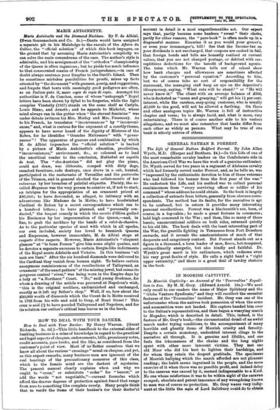MARIE ANTOINETTE.
Maris Antoinette and the Diamond Necklace. By F. de Albini. (Swan Sonnenschein and Co. 6s.)—Dante would have assigned a separate pit in his Malebolge to the rascals of the Affairs du Collier, the "official solution" of which this book impugns, on the ground that by assuming Marie Antoinette's complicity we can solve the main conundrums of the case. The author's style is admirable, and his arraignment of the " orthodox " championship of the Queen is often ingenious ; but he yields too much influence to that consecrated maxim of French jurisprudence,—in case of doubt always sentence your Dreyfus to the Devil's Island. Then he sometimes mistakes possibilities for proofs, mixes up facts attested by "the document" with guesses, gossip, and suggestions, and forgets that texts with seemingly good pedigrees are often, as an Italian puts it, mere sepia di copie di copes. Amongst his authorities is F. de Conches, some of whose "autograph" Royal letters have been shown by Sybel to be forgeries, while the light compiler Vizetelly (1867) stands on the same shelf as Carlyle, Louis Blanc, and Arneth ; and be appeals to Michelet, whose mind always ran in the gutter when "the eternal feminine" was under debate (witness his Mrs. Morley and Mrs. Freeman). As to his French, he translates " inconvenances " by "inconveni- ences," and, what is curious for the exponent of a courtly theme, appears to have never heard of the dignity of Mistress of the Robes, for he identifies " Grandes Mattresses" with " gover- nesses " ! The apparatus of guesses and combination by which M. de Albini impeaches the "official solution" is backed by a picture of Marie Antoinette's education, proclivities, " inconveniences," environment, &c., so coloured as to lead the uncritical reader to the conclusion, Habbalcuk est capable de tout. The " she-Austrian " did not play the piano, could not draw, was illiterate, romped with dirty dogs, smashed furniture, rode donkeys, once drove in a cab, hunted, participated in the nocturnales of Versailles and the pastorales of the Trianon, and in general shocked the collets-montes of her entourage by her breaches of palatial etiquette. Plainly, the so- called Moountse was the very person to connive at, if not to start, an intrigue for the appropriation of an ornament priced at £85,000; to have descended, as alleged, to intimacy with an adventuress like Madame de la Motto; to have hoodwinked Cardinal de Rohan by a secret correspondence which ran to a hundred letters ; to have planned, and "personally con- ducted," the bosquet comedy in which the cocotte d'Oliva gulled his Eminence by her impersonation of the Queen,—and, in fine, to grab the necklace by the hands of a valet-de-chambre. As to the particular species of mud with which in all epochs, our own included, society has loved to besmirch Queens and Empresses, however immaculate, AL de Albini stops at suspecte d'être suspects. However, Marie Antoinette's "eloquent glances" at "le beau Fersen " give him some slight qualms, and he devotes a separate excursus to certain Borgia-like indictments of the Royal aunts Adelaide and Victoire. In this business "all men are liars." After the six hundred diamonds were delivered to the Cardinal they vanish from human sight. To believe certain anonymous reminiscences of the recollections of Talleyrand, an ornament "of the exact pattern" of the missing jewel, but minus its gorgeous central "river," was being worn in the Empire days by a lady at "a Northern" Court. "No," said young Boehmer, for whom a drawing of the article was procured at Napoleon's wish, "this is the original necklace, undiminished and unchanged, exactly as it left ray father's shop." Well, if so, how about the 220,000 worth of diamonds which the Count de la Motto received in 1786 from his wife and sold to Gray, of Bond Street ? This crux is said (I) to have puzzled Talleyrand and Napoleon, and for its solution our author's critical lens leaves us in the lurch.


















































 Previous page
Previous page